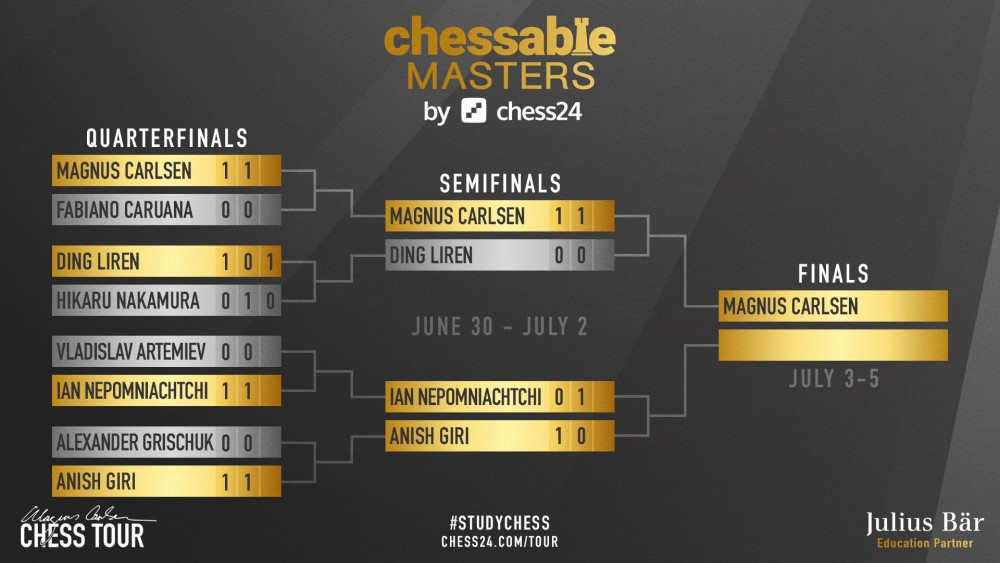


World Champion Magnus Carlsen and eleven more of the world's best chess players are competing in the Chessable Masters by chess24, the third event in the $1 million Magnus Carlsen Chess Tour, taking place from June 20 to July 5.
Tuesday’s first set of the Magnus Carlsen vs Ding Liren semifinal featured many ups and downs chess-wise — besides the whole disconnection incident. In the second set, on the other hand, Carlsen seemed to be in control throughout, despite his subpar opening play in game 1. In fact, the world champion obtained the needed mini-match victory to move on to the final in just three games.
In the last couple of months, Carlsen has shown that he is at least as strong while playing online compared to his performance over the board. Simon Williams joined the commentary team on day two of the semis and asked the Norwegian to point out the differences between playing live chess and online chess:
I would say, in general, it feels quite similar to other rapid tournaments. I guess there’s a bit of a different dynamic, maybe a little bit more difficult to be concentrated and so on from home, but I think all of the players are adjusting in time, and I don’t think it’s much different, to be fair.
One way or the other, the world champion has reached yet another final, in which he will face either Anish Giri or Ian Nepomniachtchi. Nepomniachtchi levelled the score with Giri with a 2½:1½ win in the second set. During the post-mortem interview, he was strongly critical of his and Giri’s play in the first set:
It took like five minutes for me to reveal all the evaluations thanks to the computer, and it was clear that I played like complete garbage, but the good news is that Giri was probably playing at the same level.
‘Nepo’ and Giri will decide who gets to play Carlsen in Thursday’s deciding third set.

| Second set | Game 1 | Game 2 | Game 3 |
| Magnus Carlsen | 1 | ½ | ½ |
| Ding Liren | 0 | ½ | ½ |
Carlsen surprisingly chose the King’s Indian Defence with black in game 1. His handling of the opening was not up to standard, but a clever pawn sacrifice allowed him to get back into the game:
26...a5 is not the computer’s favourite move, but it’s a good way to avoid suffering endlessly in a strategically inferior position — Black lost a pawn but cemented his knight on a good square after 27.Ra1 (in hindsight, 27.b5 would have been better) Na6 28.bxa5 bxa5 29.Rxa5 Nc5.
Ding still had the upper hand, but ended up overpushing after facing strong positional play by his opponent. Later on, the Chinese blundered the game away in one move:
66.Qb3 loses immediately to 66...Rc1+. White resigned.
A rather uneventful draw in game 2 meant Carlsen needed one more point to reach the final, and he put an end to the match with a convincing 29-move win in game 3 — Ding seemed too eager to create complications and miscalculated in the early middlegame.
Select an entry from the list to switch between games
| Second set | Game 1 | Game 2 | Game 3 | Game 4 |
| Ian Nepomniachtchi | ½ | 1 | ½ | ½ |
| Anish Giri | ½ | 0 | ½ | ½ |
The second set of this semi saw Giri wasting some chances that could have potentially given him a quick pass to the final. In game 1, he got a good position with a strong central knight but could only convert it into a 3 v 2 rook endgame, which ‘Nepo’ safely held. The Russian went on to score a clean win in game 2, making the most of Giri’s tame handling of the opening — Black’s knight found itself without escape on move 28:
28.f3 and White grabbed the helpless knight soon after. Giri resigned on move 39.
Game 3 seemed to be headed to an inevitable draw in a rook endgame, except that ‘Nepo’ blundered on move 48. Sadly for him, however, Giri did not find the punishing response:
Black’s 48...Ke5 allowed 49.g5, when 49...fxg5 50.Rxg5+ Rxg5 51.hxg5 is a winning pawn endgame for White. Giri did not find the strong pawn push and played 49.Kf2 instead, and White does not have enough resources to get the win.
‘Nepo’ only needed a draw in game 4, which he managed without any hassle.
Select an entry from the list to switch between games